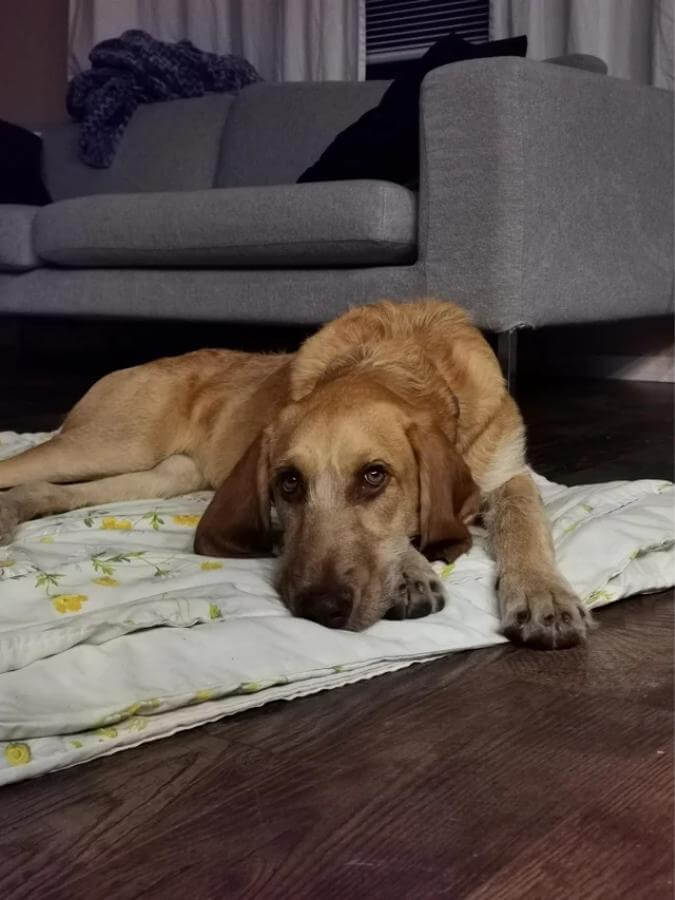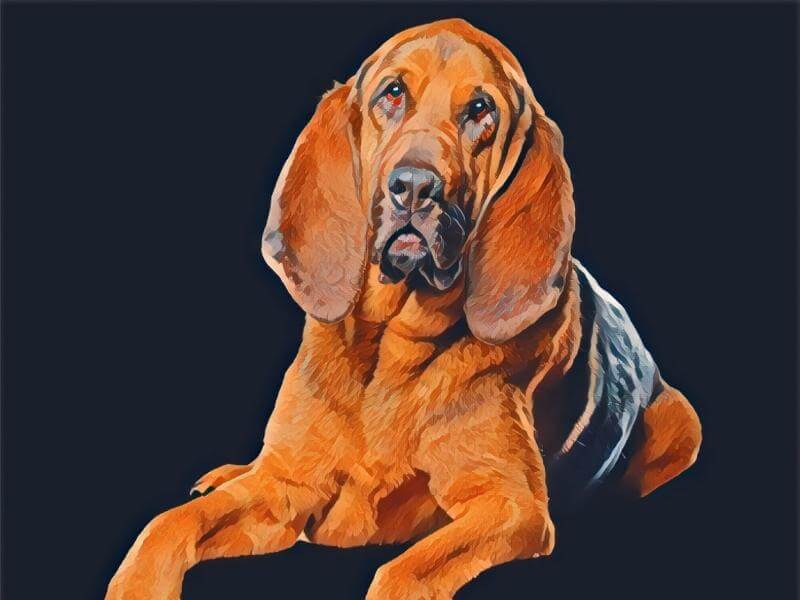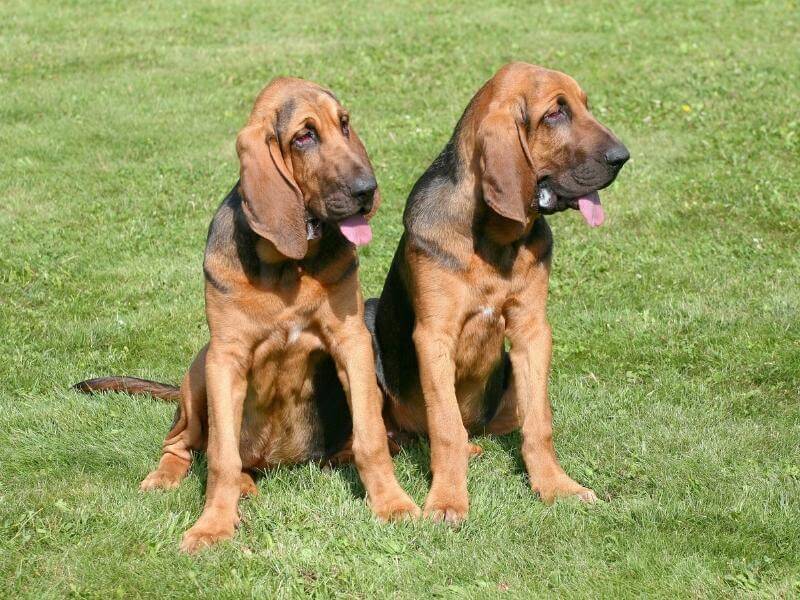The Bloodhoodle is a designer mix between a Poodle and a Bloodhound. This unique dog combines a waterfowl retriever and a scent hound.
Poodle mixes are by no means new, but a Bloodhound-Poodle mix seems like an exciting cross. However, after some research, I found that this Doodle dog brings quite a lot to the table.
It might even be the perfect dog for you. Let’s find out!
What is a Bloodhoodle?
The Bloodhoodle is a result of cross-breeding a Bloodhound and a Poodle. They can also be called a Bloodle or Poohound.

These mixed breeds, also known as designer dogs, create a new hybrid breed with characteristics of both the father and mother.
The Bloodhound-Poodle mix is one of the most interesting of the so-called designer dogs because of the unique history of the parent breeds.
History of the Parent Breeds
The Bloodhound and the Poodle both share a common origin. They were bred to be hunting dogs. Despite having the same origin, each breed passes on unique traits to the Bloodhoodle.
By becoming familiar with each breed’s history, you’ll better understand what each parent brings to the Bloodhound-Poodle mix.
Bloodhound

The Bloodhound ancestry originated as far back as the 3rd century, but Western Europe created what we now know as the Bloodhound about 1000 years ago.
The pre-reformation church is credited with Bloodhound development at that time. Only the rich, for example, royalty in France and England, owned the hounds. They were kept in well-cared-for packs at the monasteries by their wealthy owners.
The monks improved on the breed, calling them “blooded hounds.” This term had nothing to do with their scenting skill but described that their owners were of aristocratic bloodlines.
The aristocrats discovered the dogs were great hunting companions. They could follow the trail of deer, birds, and other wild game all day, alerting the hunter when found. Hunters began to depend on the dogs’ powerful tracking skills to finish successful hunts.
Since then, these dogs have earned a reputation for following the scent of someone with a great single focus. Law enforcement began using them in searches for lost children, fleeing criminals, and anything else law enforcement needed to be found.

Bloodhounds have been named as heroes routinely when it comes to finding lost children alive. Once they get the child’s scent from a piece of clothing, they’ll spend hours without a break to find them.
Additionally, hunters still use these dogs to hunt and sniff out prey, although the hunters no longer need to be royalty. The once “blooded hounds” are now named Bloodhounds.
Bloodhounds have transitioned to become family dogs. They are still used as scent hounds and hunting dogs.
Marti Michalis, a dog trainer and owner of two Bloodhounds, says: “the breed is fun-loving and loyal, making it perfect for any family.”
Poodle

Poodles were bred in Germany in the 1600s. They were bred to accompany hunters to retrieve waterfowl and upland game from the water or field.
When temperatures were freezing, their owners would leave hair on their chests and joints to provide sufficient insulation from the cold.
Poodles slowly migrated from the hunting grounds to people’s homes. Many Europeans, especially the French, took a liking to Poodles, and the breed began to spread across the continent.
In France, the Poodle was a great attraction as circus performers. The breed was selectively bred to produce a smaller dog for easy transportation and handling. Outside its circus and hunting activities, the Poodle became extremely popular as a much-loved companion.
The Poodle is the second most intelligent dog breed after the Border Collie. They are agile with lots of energy. They are loving, loyal companions, good with children, and very easy to train.
Appearance
Bloodhounds are large, heavy, strong dogs. They come in three different colors.
Standard Poodles have long, athletic bodies. They have a curly coat that comes in many varied, beautiful colors.
The puppies are in assorted colors depending on their DNA markers from the parents. Their coat can be smooth or curly or a mix of both. Since both breeds have larger ears, puppies also have larger ears.
Coat Type
The coats are low-level curly and might need brushing. Bloodhounds shed, so while the Bloodhound Poodle mix may shed some, it won’t be much since Poodles don’t shed at all.
The curls could be smooth, but if they are more like the Poodle parent, then some grooming may be required aside from brushing.
If your hybrid pup has thick curly hair, shearing can help it from matting. It will also help keep things clean from weeds, dirt, mud, bugs, etc.
Coat Colors
Poodles have the potential to be a ton of different colors. Bloodhounds typically only have three possible coat colors: tan, red, and liver [1]www.akc.org/dog-breeds/bloodhound.
When you combine both breeds’ coat colors, you get a long list of potential coat colors for the Bloodle:
- Black
- Tan
- White
- Grey
- Silver
- Blue
- Sable
- Brown (or Chocolate)
- Cream
- Red
- Liver
- Apricot
Their coat can be one solid color or a mix of these colors, such as parti or tri-color. A Bloodhoodle can also have unique coat patterns such as tuxedo, merle, or phantom.
Size
Bloodhounds are bigger dogs than the standard Poodle, although the Poodle is not much more miniature. Puppies grow into bigger dogs like their parents. Some may be broad in the chest, like the Bloodhound parent. However, height stays the same as the parents since they don’t vary in height much.
Height
A Bloodhoodle will likely range in height from 23-27 inches. Their final adult size will depend on the genes passed on by the parents. The size of both parents offers the best insight into how big your Bloodhound-Poodle mix will grow.
For reference, the standard heights for both parent breeds are provided below:
- The average height for a male Bloodhound is 25 to 27 inches at the shoulder. The female stands at 23-25 inches.
- Standard Poodles average 18-24 inches for males and 18-19 inches for females.
Weight
An adult Bloodhound-Poodle mix will weigh between 60-140 lbs. This is quite an extensive range. However, it will depend on gender and genetics passed on from the parents.
For reference, the standard weights for both parent breeds are provided below:
- Male Bloodhounds average 90-140 lbs in weight. Females are slightly smaller at 80-100lbs.
- Male standard Poodles weigh in on average at 60-70 lbs. Females are 40-50lbs.
Traits and Characteristics

Personality
The Bloodhound-Poodle mix has an excellent temperament. As with any dog, training should start early to socialize in new situations, people, and other animals.
Despite the parent breeds being hunters, they are excellent family dogs, happy and intelligent. The mixed breed barks to alert people at the door, then usually quiets down.
Exercise is essential, so that this Doodle dog doesn’t get bored. Once they have been walked, played with, fed, and watered, they tend to sleep. Leaving them alone all day can create that boredom, so tiring them out first keeps them mostly sleeping while you are gone.
One trait a Bloodhoodle may have is drooling. Owners of Bloodhounds say to expect drooling. Standard Poodle owners say their Poodles don’t drool. So a mixed breed with these parents may also drool heavily.
Common Health Issues
A Bloodhound-Poodle mix inherits the risk of a few common health issues to both breeds. Some of these include[2]www.akc.org/dog-breeds/poodle-standard:
- Epilepsy
- von Willebrand’s disease
- Legg-Calve-Perthes
- Hip dysplasia
- Elbow dysplasia
- Eye disorders
Start vet care early, so any health issues are caught early. Plus, doing this gets your puppy used to the vet, making future visits easy. The vet also suggests the best foods or supplements for your mix based on the parents’ requirements.
Lifespan of a Bloodhoodle
The average life span of the Bloodhound-Poodle mix is approximately 10-15 years.
Bloodhound-Poodle Mix Breeders
Currently, I could not find any breeders that breed the Bloodhound-Poodle mix. Due to the rising popularity in Doodle dogs, I am confident that this will change soon.
If you’re looking for a Bloodhoodle puppy, then keep your eyes out for listings on Google. You can get in touch with other Bloodhound-Poodle mix owners on social media and ask where they bought their puppy from.
Final Thoughts
Combining a Bloodhound and a Poodle may seem strange at first. However, the more you see how similar these breeds are in many ways, the easier it is to imagine. Luckily, the Bloodhound and standard Poodle mix is a reality, and it’s a fantastic Doodle dog option for all families.
In this post, I covered all sorts of things relating to the Bloodhoodle:
- History of the Parents
- Appearance of the Bloodhoodle
- Size of the Bloodhoodle
- Traits and Characteristics
- How to find Bloodhoodle puppies
If you’re curious about other Poodle-mixes, you should check out my complete guide to Doodle breeds!

References

